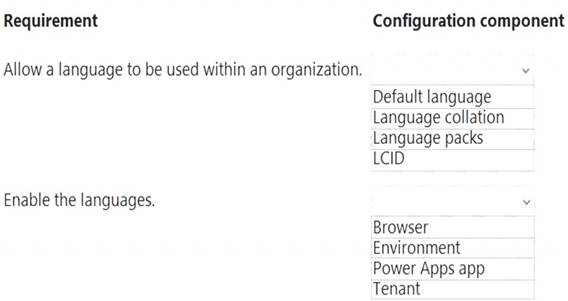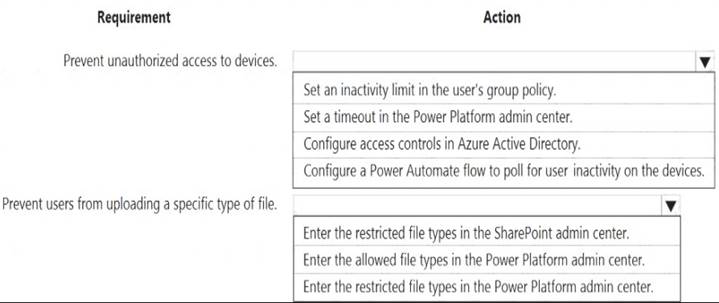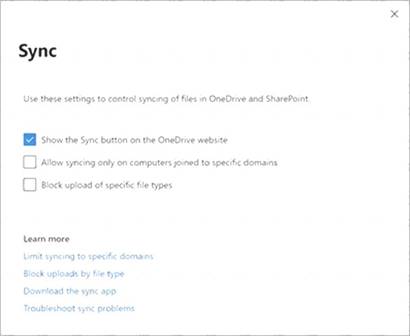- (Exam Topic 3)
A company uses a model-driven Power Apps app in a new environment. The base language is English. You need to configure French and Spanish.
Which configuration component should you use? To answer, select the appropriate options in the answer area.
NOTE: Each correct selection is worth one point.
Solution:
Box 1: Language packs
Before users can start using a Language Pack to display a language, the Language Pack must be enabled in your organization.
Box 2: Environment Enable the language
These settings can be found in the Microsoft Power Platform admin center by going to Environments > [select an environment] > Settings > Product > Languages.
Reference: https://docs.microsoft.com/en-us/power-platform/admin/enable-languages
Does this meet the goal?
Correct Answer:
A
- (Exam Topic 3)
You create a model-driven app for an automobile parts help desk.
A help desk agent uses a form to gather information about customers' automobiles in two custom tables. The names of the tables are Client and Automobile,
The form must prepopulate the following information about the customer from the client table:
• First name
• Last name
The agent must be able to type the following information about the automobile:
• Automobile make
• Automobile model
You need to implement the form.
What should you configure? To answer, select the appropriate options in the answer area. NOTE: Each correct selection is worth one point.
Solution:
Does this meet the goal?
Correct Answer:
A
- (Exam Topic 3)
You deploy a Power Vitlu.il Agents chatoot that integrates with Dynamics 365 Omnichannel for Customer Service.
You observe that the chatbot is not able to recognize the questions asked by use's.
You need to ensure that the chatbot can respond to unrecognized questions. The solution must minimize administrative effort.
What should you do?
Correct Answer:
A
- (Exam Topic 3)
A company is configuring a Power Apps portal using Microsoft Dataverse. The company requires the following: Only authenticated users must be able to sign into the portal.
Only authenticated users must be able to sign into the portal. Authenticated users must have varying degrees of access to the different parts of the portal.
Authenticated users must have varying degrees of access to the different parts of the portal. Users must enter one of several external identities when creating an account during the open registration process.
Users must enter one of several external identities when creating an account during the open registration process.
You need to configure user authentication and permissions.
Which component should you use? To answer, select the appropriate options in the answer area.
NOTE: Each correct selection is worth one point.
Solution:
Box 1: Contact table record
In Power Apps portals, each authenticated portal user is associated with a contact record in Microsoft Dataverse.
Box 2: Web roles
Portal users must be assigned to web roles to gain permissions beyond unauthenticated users. Reference:
https://docs.microsoft.com/en-us/powerapps/maker/portals/configure/configure-portal-authentication
Does this meet the goal?
Correct Answer:
A
- (Exam Topic 3)
A company deploys several model-driven apps. The company uses shared devices in their warehouse. The devices are always powered on. Users log on to the devices and then launch the apps to perform actions.
Unauthorized users recently uploaded several files after another user failed to log out of a device. The company needs to prevent these incidents from occurring in the future.
You need to configure the solution to prevent the reported security incidents. What should you do? To answer, select the appropriate options in the answer area. NOTE: Each correct selection is worth one point.
Solution:
Graphical user interface, text, application Description automatically generated
Box 1: Set a timeout in the Power Platform admin center.
To enforce users to reauthenticate after a pre-determined period of time, admins can set a session timeout for their individual environments. Users can only remain signed in the application for the duration of session. The application signs out the user when the session expires. Users need to sign in with their credentials to return to customer engagement apps.
Note: Configure session timeout In the Power Platform admin center, select an environment.
In the Power Platform admin center, select an environment.  Select Settings > Product > Privacy + Security.
Select Settings > Product > Privacy + Security. Set Session Expiration and Inactivity timeout. These settings apply to all users.
Set Session Expiration and Inactivity timeout. These settings apply to all users.
Incorrect:
Configure inactivity timeout In the Power Platform admin center, select an environment.
In the Power Platform admin center, select an environment.  Select Settings > Product > Privacy + Security.
Select Settings > Product > Privacy + Security. Set Session Expiration and Inactivity timeout. These settings apply to all users. Box 2: Enter the restricted file types in the SharePoint admin center.
Set Session Expiration and Inactivity timeout. These settings apply to all users. Box 2: Enter the restricted file types in the SharePoint admin center.
To block uploading of specific file types Go to the Settings page of the new SharePoint admin center,
Go to the Settings page of the new SharePoint admin center,  Select Sync.
Select Sync.
Graphical user interface, text, application Description automatically generated
 Select the Block upload of specific file types check box.
Select the Block upload of specific file types check box. Enter the file name extensions you want to block, for example: exe or mp3.
Enter the file name extensions you want to block, for example: exe or mp3.  Select Save.
Select Save.
Reference:
https://docs.microsoft.com/en-us/power-platform/admin/user-session-management https://docs.microsoft.com/en-us/onedrive/block-file-types
Does this meet the goal?
Correct Answer:
A

